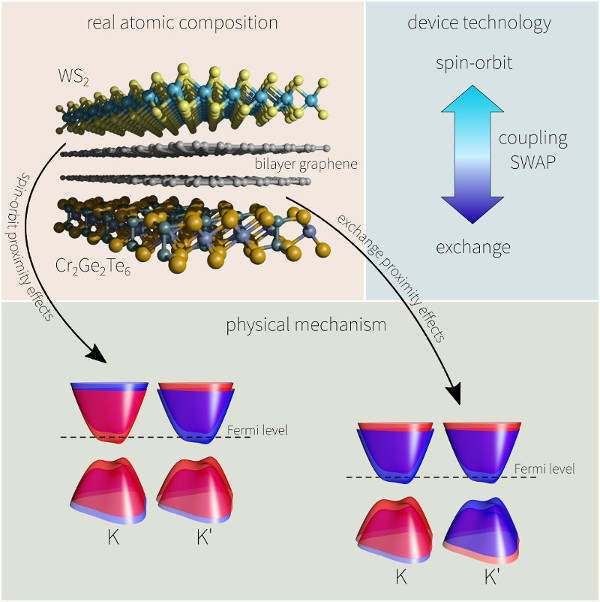Interaction on-demand — ex-so-tic device
We propose swapping two different interactions for itinerant electrons by gating. While spin-orbit coupling preserves time-reversal symmetry, and leads to such phenomena as topological quantum spin Hall effect or spin relaxation anisotropy, exchange coupling breaks time reversal symmetry, and renders the electronic system magnetic. Swapping the two couplings provides a two-way route between time-reversal symmetric and magnetic physics. The device is built on a platform comprising bilayer graphene, sandwiched between a monolayer transition metal dichalcogenide and a 2D ferromagnetic semiconductor. Electrons from the top layer of graphene feel the spin-orbit coupling from the transition metal dichalcogenide, while electrons from the bottom layer feel the magnetic exchange from the ferromagnet. Due to the gate control of the layer polarization we can achieve the swapping operation. The idea is rather intuitive: the layer polarization also selects the spin coupling for a given band. By changing the layer polarization, the couplings are swapped. This is a very robust idea, supported by systematic atomistic simulations. For more details see publication:
Swapping Exchange and Spin-Orbit Coupling in 2D van der Waals Heterostructures
K. Zollner, M. Gmitra, J. Fabian, Phys. Rev. Lett. 125, 196402 (2020)
https://doi.org/10.1103/PhysRevLett.125.196402

Calculated atomic model for the device (top left) and physical mechanism of proximity effects on bilayer graphene band structure near K points (bottom), and schematics of the SWAP technology.
Kľúčom k rébusu je zmena paradigmy. Dvojrozmerné materiály, niekedy až jeden atóm tenké, môžu byt poukladané do viacvrstvových štruktúr, v ktorých sú navzájom viazané slabými van der Waalsovými interakciami. To umožní, že si jednotlivé materiály zachovajú svoje špecifické vlastnosti vo svojich rovinách, ale môžu prenášať interakcie medzi rovinami prostredníctvom proximálnych interakcií. Na druhej strane sa tu otvára možnosť prepínať medzi ich vlastnosťami cez modifikovanie Fermiho plochy pomocou naloženého napätia (kontrolnej páčky). Fermiho plocha je súbor elektrónových stavov, ktoré sú v prevažnej miere zodpovedné za špecifické vlastnosti materiálu odzrkadľujúc zároveň fundamentálne symetrie.
V spolupráci s Univerzitou v Regensburgu (Nemecko) bol navrhnutý a teoretický študovaný vrstevnatý sendvičový systém, tzv. ex-so-tic súčiastka, ktorá pozostáva s dvojvrstvy grafénu, dvojrozmerného feromagnetu Cr2Ge2Te6 a monovrstvy polovodiča WS2 . Bolo ukázané, že v systéme je možné prepínať medzi výmennou („ex“ – exchange) interakciou a spinovo-orbitálnou („so“ – spin-orbit) interakciou pomocou elektrického poľa. Pomocou teoretických výpočtov bolo demonštrované, že daná heteroštruktúra ponúka výmennú interakciu alebo spinovo-orbitálnu interakciu na požiadanie. Navrhnutá súčiastka, ktorej fyzikálne vlastnosti sú kontrolované elektrickým poľom predstavuje prototyp pre tvorbu nových spintronických zariadení konštruovaných z dvojrozmerných materiálov.